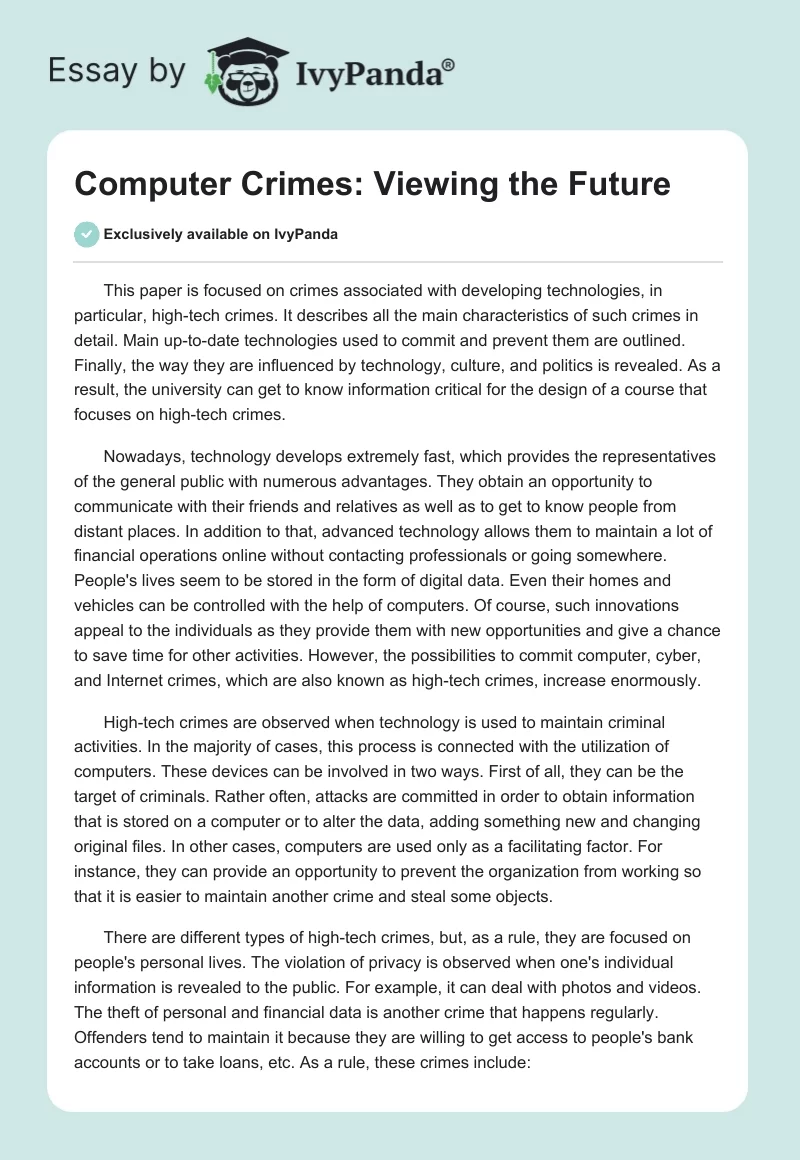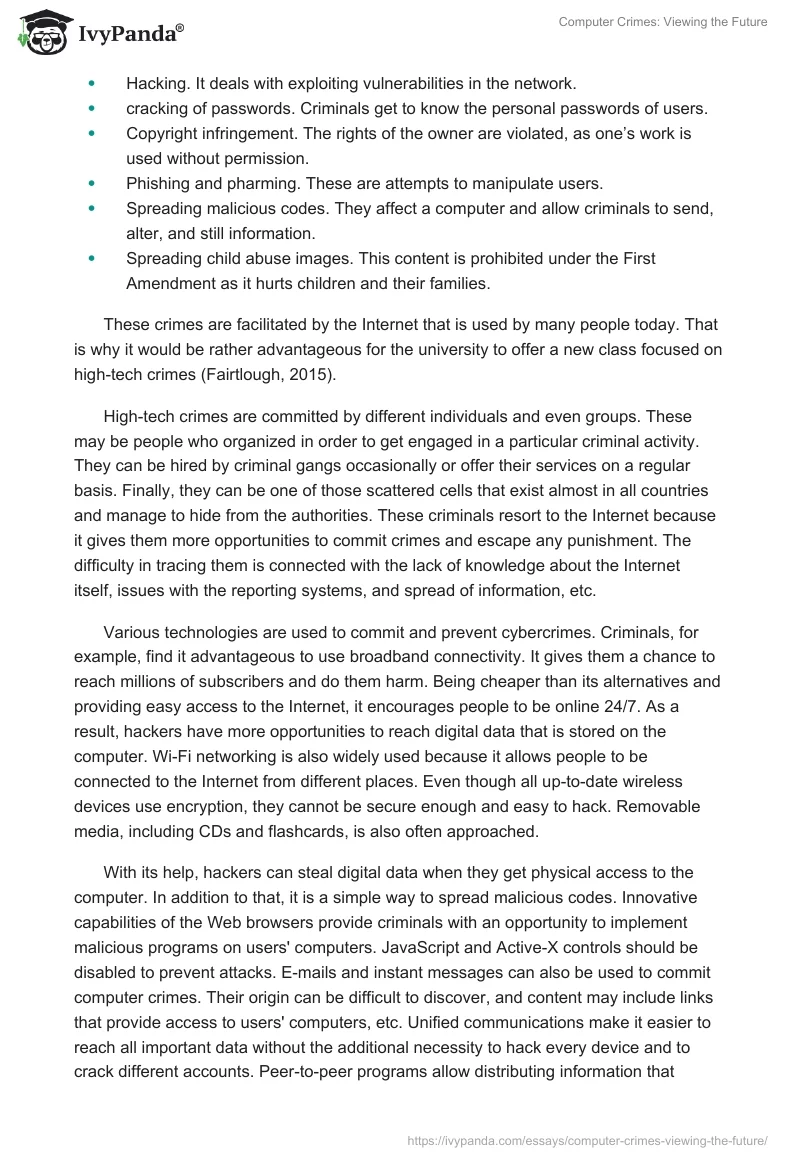This paper is focused on crimes associated with developing technologies, in particular, high-tech crimes. It describes all the main characteristics of such crimes in detail. Main up-to-date technologies used to commit and prevent them are outlined. Finally, the way they are influenced by technology, culture, and politics is revealed. As a result, the university can get to know information critical for the design of a course that focuses on high-tech crimes.
Nowadays, technology develops extremely fast, which provides the representatives of the general public with numerous advantages. They obtain an opportunity to communicate with their friends and relatives as well as to get to know people from distant places. In addition to that, advanced technology allows them to maintain a lot of financial operations online without contacting professionals or going somewhere. People’s lives seem to be stored in the form of digital data. Even their homes and vehicles can be controlled with the help of computers. Of course, such innovations appeal to the individuals as they provide them with new opportunities and give a chance to save time for other activities. However, the possibilities to commit computer, cyber, and Internet crimes, which are also known as high-tech crimes, increase enormously.
High-tech crimes are observed when technology is used to maintain criminal activities. In the majority of cases, this process is connected with the utilization of computers. These devices can be involved in two ways. First of all, they can be the target of criminals. Rather often, attacks are committed in order to obtain information that is stored on a computer or to alter the data, adding something new and changing original files. In other cases, computers are used only as a facilitating factor. For instance, they can provide an opportunity to prevent the organization from working so that it is easier to maintain another crime and steal some objects.
There are different types of high-tech crimes, but, as a rule, they are focused on people’s personal lives. The violation of privacy is observed when one’s individual information is revealed to the public. For example, it can deal with photos and videos. The theft of personal and financial data is another crime that happens regularly. Offenders tend to maintain it because they are willing to get access to people’s bank accounts or to take loans, etc. As a rule, these crimes include:
- Hacking. It deals with exploiting vulnerabilities in the network.
- cracking of passwords. Criminals get to know the personal passwords of users.
- Copyright infringement. The rights of the owner are violated, as one’s work is used without permission.
- Phishing and pharming. These are attempts to manipulate users.
- Spreading malicious codes. They affect a computer and allow criminals to send, alter, and still information.
- Spreading child abuse images. This content is prohibited under the First Amendment as it hurts children and their families.
These crimes are facilitated by the Internet that is used by many people today. That is why it would be rather advantageous for the university to offer a new class focused on high-tech crimes (Fairtlough, 2015).
High-tech crimes are committed by different individuals and even groups. These may be people who organized in order to get engaged in a particular criminal activity. They can be hired by criminal gangs occasionally or offer their services on a regular basis. Finally, they can be one of those scattered cells that exist almost in all countries and manage to hide from the authorities. These criminals resort to the Internet because it gives them more opportunities to commit crimes and escape any punishment. The difficulty in tracing them is connected with the lack of knowledge about the Internet itself, issues with the reporting systems, and spread of information, etc.
Various technologies are used to commit and prevent cybercrimes. Criminals, for example, find it advantageous to use broadband connectivity. It gives them a chance to reach millions of subscribers and do them harm. Being cheaper than its alternatives and providing easy access to the Internet, it encourages people to be online 24/7. As a result, hackers have more opportunities to reach digital data that is stored on the computer. Wi-Fi networking is also widely used because it allows people to be connected to the Internet from different places. Even though all up-to-date wireless devices use encryption, they cannot be secure enough and easy to hack. Removable media, including CDs and flashcards, is also often approached.
With its help, hackers can steal digital data when they get physical access to the computer. In addition to that, it is a simple way to spread malicious codes. Innovative capabilities of the Web browsers provide criminals with an opportunity to implement malicious programs on users’ computers. JavaScript and Active-X controls should be disabled to prevent attacks. E-mails and instant messages can also be used to commit computer crimes. Their origin can be difficult to discover, and content may include links that provide access to users’ computers, etc. Unified communications make it easier to reach all important data without the additional necessity to hack every device and to crack different accounts. Peer-to-peer programs allow distributing information that violates copyright laws. E-commerce and online banking give hackers an opportunity to reach people’s finances (Goodman, 2012). In this way, the influence of developing technologies on high-tech crimes is undeniable.
Different security platforms and programs are created to prevent such crimes. Mainly, they are focused on improved encryption opportunities. Among the most recent technologies is mapping. These applications can be of different types. They can focus on geographic information and remote sensing to reveal where crimes are happening. Smartphone apps make it easier to record or take photos of criminal activities and to reach the police. Web reporting allows the authorities to know that crimes are happening or are going to happen. They streamline the identification of criminals and simplify prevention (Gruber, n.d.).
Of course, it is also advantageous to update passwords, secure computers with firewall settings, be social media savvy, use built-in security features of mobile devices, and limit the usage of Wi-Fi hotspots (Linington, 2014). However, the way people treat and use these technologies depends greatly on their cultures. For instance, the majority of Americans use the Internet on an everyday basis and maintain a lot of financial operations with its help. Society makes them be available online, as education and job are almost not possible without technologies regardless of people’s specialization. Similar tendencies are seen in other countries as well. In South Korea, for example, the population can easily use free Wi-Fi and mobile apps so that they can be approached anytime. Such tendencies make it easier for hackers to commit crimes and affect people’s lives (Schuurman, 2013).
Politicians also deal with high-tech crimes. They develop various initiatives and policies that are expected to prevent and overcome computer-related criminal activities. The most demonstrating example here is the First Amendment. With its adoption, major freedoms were guaranteed to people. In its framework, copyright violations became treated as crimes, the secrecy of communications was ensured, and the necessity to align with community standards and legislative acts was underlined. Thus, politicians defined the information, which is considered illegal even today. For example, sexual portrayals and situations with kids are not allowed to be in free access to the Internet. They’re also the limitation in their storage. Laws protect children and families through the application of standards related to those materials are cannot be shared. Politicians and policymakers also made Internet gambling a crime. Still, different aspects of the First Amendment are argued today, which emphasizes the necessity to address computer crimes additionally (Britz, 2013).
Thus, it can be concluded that developing technologies make it easier for hackers to commit high-tech crimes. Even though people seem to benefit from the advanced features of their devices and the Internet, they become more vulnerable. They can be manipulated by criminals, their personal and financial information can be stolen with the help of cracked passwords. Malicious codes, sexual and child abuse content can be spread, and copyrighting rights can be violated. As the representatives of the general public tend to be online almost 24/7, criminals obtain more opportunities to affect them. Being aware of this fact, professionals and policymakers develop special technologies and initiatives that improve people’s privacy and prevent attacks. However, improvement is still needed in this sphere. If the university offers a high-tech crime class, it will contribute to this sphere because students will learn how to prevent computer crimes and avoid them in the future.
References
Britz, M. (2013). Computer forensics and cyber crime: An introduction. New York, NY: Pearson.
Fairtlough, J. (2015). Cyber crime investigation. San Clemente, CA: LawTech Publishing Group.
Goodman, M. (2012). How technology makes us vulnerable. Web.
Gruber, C. (n.d.). 3 ways to prevent crime with technology. Web.
Linington, D. (2014).Top 8 tips to prevent cybercrime. Web.
Schuurman, D. (2013). Shaping a digital world: Faith, culture and computer technology. Dowers Grove, IL: IVP Academic.


